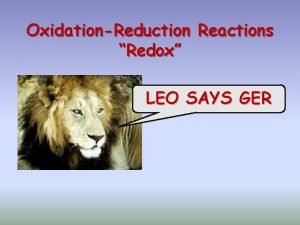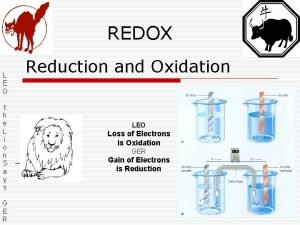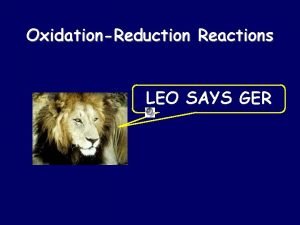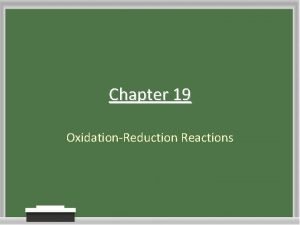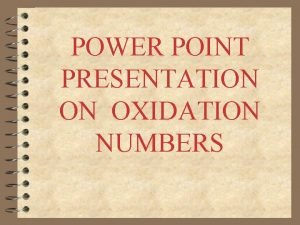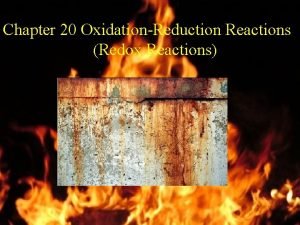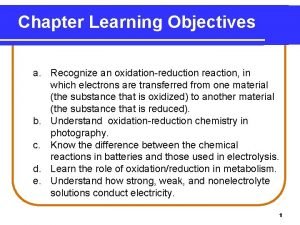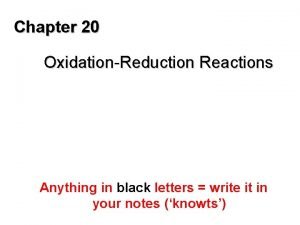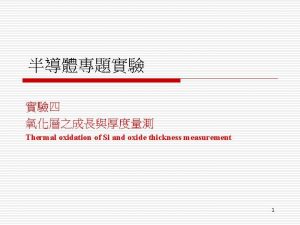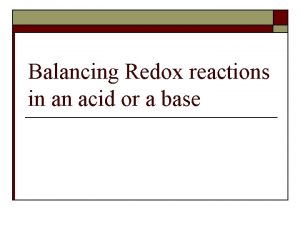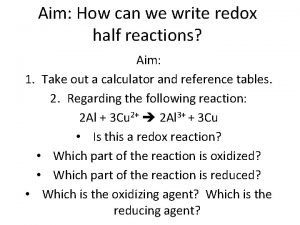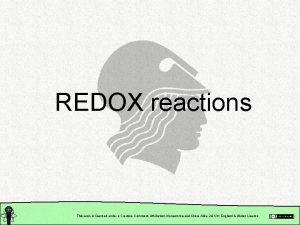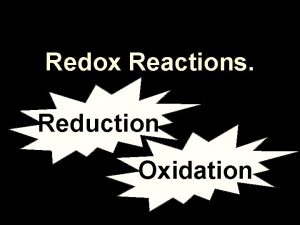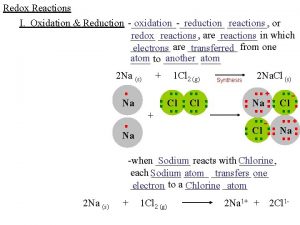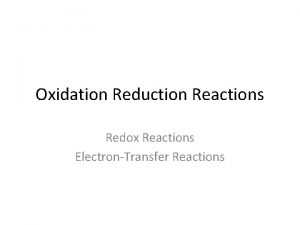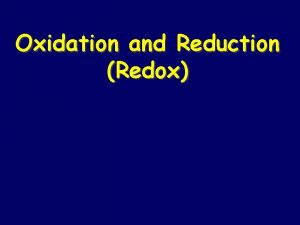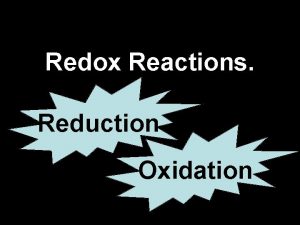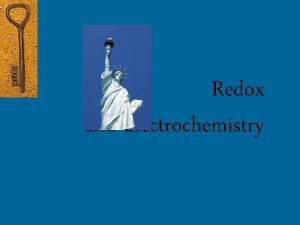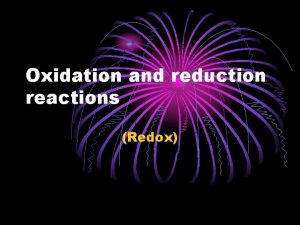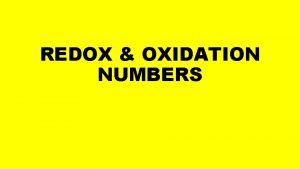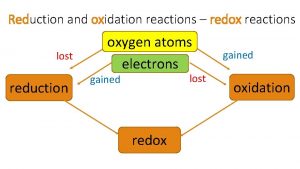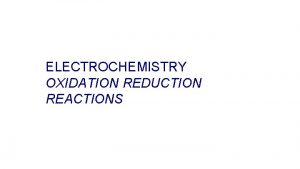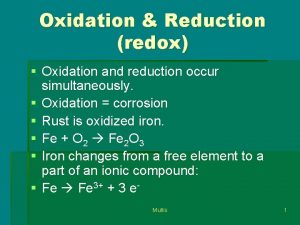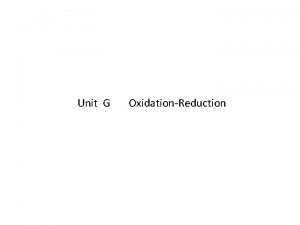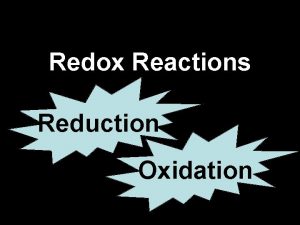Oxidation Reduction Reactions Redox This is LEO He



















- Slides: 19

Oxidation & Reduction Reactions Redox This is LEO He says GER

Redox Reactions • A reaction in which electrons are transferred from one atom to another is called an ________. • For simplicity, chemists often refer to oxidation–reduction reactions as ________.

Determining Oxidation Numbers 1. The oxidation number for any uncombined elements or diatomic molecule is ________ § § § For example: C O 2 S Cl 2

Determining Oxidation Numbers 2. The oxidation number for a monatomic ion is its ________ § § For example: Ca+2 Br -1 Mg. Br 2 = Mg = Br =

Determining Oxidation Numbers 3. The oxidation number of Hydrogen is usually _____. The exception is in a metal hydride where the oxidation number will be _____ § § For example: HCl H = H 2 SO 4 H = Na. H H =

Determining Oxidation Numbers 4. The oxidation number of oxygen is usually _____ EXCEPT in ________. Then it is _____ § § For example: Mg. O O = KCl. O 3 O = H 2 O 2 O =

Determining Oxidation Numbers 5. In binary compounds (nonmetal + nonmetal) the positive one is first and the negative one is second § § § For example: PCl 3 P = Cl = CO 2 O = C=

Determining Oxidation Numbers 6. The sum of the oxidation numbers for all atoms in a neutral compound is ________ § For example: H 2 O

Determining Oxidation Numbers 7. The sum of the oxidation numbers in a polyatomic ion is equal to the ________ of the polyatomic ion • For example: • HCO 3 -1

Oxidation Numbers • Determine the oxidation numbers of all species in the following examples: • H 2 • Ca. Cl 2 • KCl. O 4

Redox Reactions • Oxidation reduction reactions (redox reactions) – electrons from one atom are ________ to another atom • ________ – loss of electrons • ________ – gaining of electrons • LEO says GER • Oxidation cannot occur without reduction & vice versa

Redox Reactions • ________ – substance that • oxidized another substance by gaining its electrons (this is substance that is reduced) ________ – substance that reduced another substance by loosing its electrons (this is the substance that is oxidized)

Identifying Components of a Redox Reactions • Identify the oxidation numbers of all species, what is oxidized, reduced, the oxidizing agent, and the reducing agent in the following reaction: • KBr + Cl 2 2 KCl + Br 2

Identifying Components of a Redox Reactions Identify the oxidation numbers of all species, what is oxidized, reduced, the oxidizing agent, and the reducing agent in the following reaction: Ni + Cl 2 Ni. Cl 2

Balancing Redox Reactions (Oxidation Number Method) Steps for Balancing Redox Reactions using the Oxidation Number Method 1. Assign oxidation numbers for all atoms 2. Identify what is oxidized, reduced, oxidizing agent, 3. 4. reducing agent, and the number of electrons gained and lost Make the change electrons equal by placing a coefficient in front of the number of electrons gained and lost Move the coefficients down and complete balancing by conventional methods

Example • Balance the following equation using the oxidation number method • Cu + HNO 3 Cu(NO 3)2 + NO 2 + H 2 O Now finish by conventional methods This just gives you a starting place

Another Example • Balance the following equation using the oxidation number method • HCl + HNO 3 HOCl + NO + H 2 O

Try this one… • Balance the following equation using the oxidation number method • Sn. Cl 4 + Fe Sn. Cl 2 + Fe. Cl 3

One More… • Balance the following equation using the oxidation number method • Sn + HNO 3 + H 2 O H 2 Sn. O 3 + NO
 Leo says ger chemistry
Leo says ger chemistry Leo ger oxidation reduction
Leo ger oxidation reduction Leo ger oil rig
Leo ger oil rig Leo and ger examples
Leo and ger examples Half redox reaction
Half redox reaction Sig figs for logs
Sig figs for logs What is redox reaction
What is redox reaction Oxidation reduction reactions chapter 19 review
Oxidation reduction reactions chapter 19 review Chapter 19 review oxidation-reduction reactions answers
Chapter 19 review oxidation-reduction reactions answers 10 examples of oxidation and reduction reactions
10 examples of oxidation and reduction reactions Chapter 20 oxidation-reduction reactions answer key
Chapter 20 oxidation-reduction reactions answer key Oxidation–reduction reactions
Oxidation–reduction reactions Half reduction reaction
Half reduction reaction Oxidation–reduction reactions
Oxidation–reduction reactions Leo says ger
Leo says ger Redox leo ger
Redox leo ger Deal-grove model
Deal-grove model Balancing redox reactions in acid
Balancing redox reactions in acid Writing half reactions
Writing half reactions How redox reactions work
How redox reactions work
